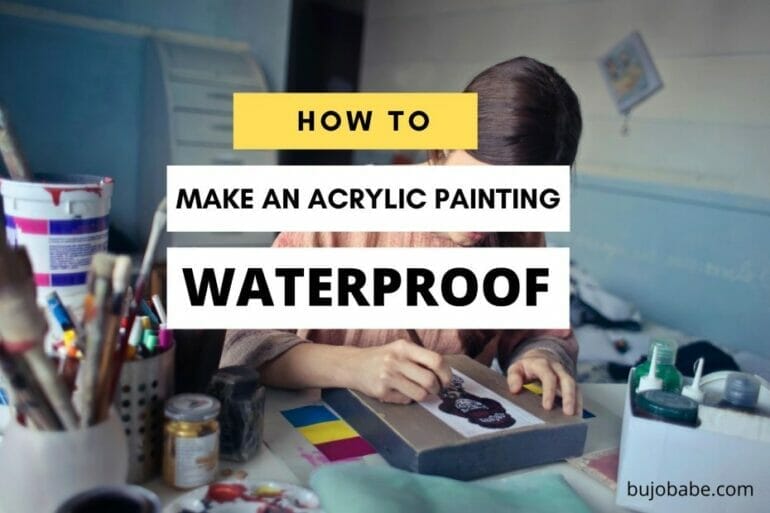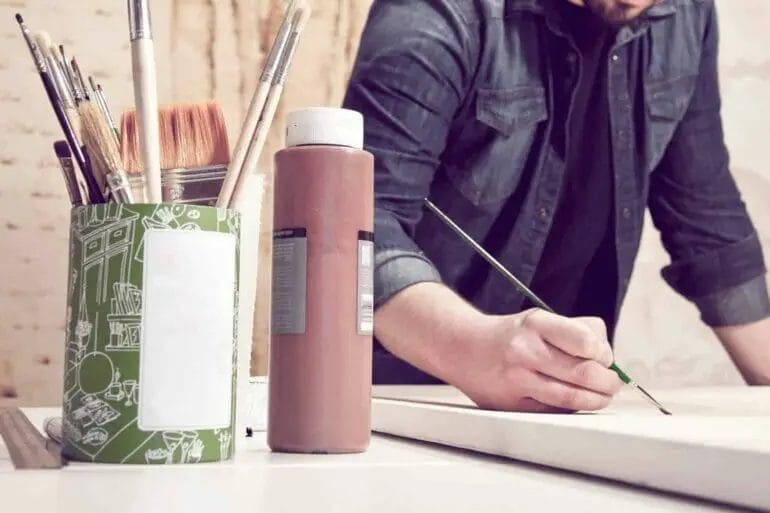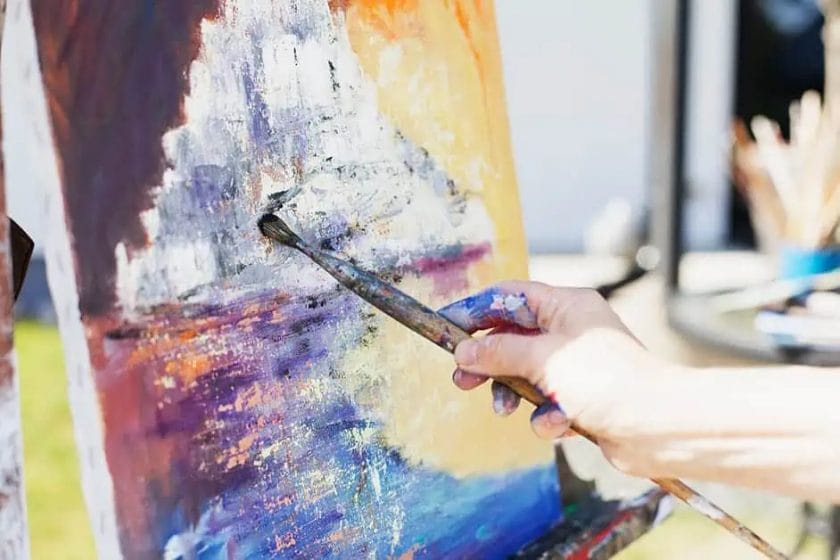Are you tired of worrying about your acrylic paintings getting damaged by moisture? Well, worry no more! In this article, we will guide you on how to make your acrylic paintings waterproof, allowing you to confidently display and protect your artwork for years to come.
Acrylic paint is known for its vibrant colors and versatility, but it can be susceptible to water damage if not properly sealed. Fortunately, there are several methods you can employ to make your acrylic paintings waterproof.
One of the most effective ways to waterproof your acrylic paintings is by using a varnish. Applying a layer of varnish not only enhances the visual appeal of your artwork but also creates a protective barrier that shields it from moisture and other environmental factors.
Another technique you can use to make your acrylic paintings waterproof is by mixing a waterproofing medium or additive directly into your paint. These additives alter the properties of the acrylic paint, making it more resistant to water and preventing it from absorbing moisture.
In addition to varnishing and using waterproof additives, it is important to ensure that you are working on a suitable surface. Priming your canvas or using a water-resistant substrate can further enhance the waterproofing capabilities of your acrylic paintings.
By following these tips and techniques, you can successfully make your acrylic paintings waterproof, giving you peace of mind and allowing your artwork to withstand the test of time.

Essential Supplies for Waterproofing Your Acrylic Paintings
When it comes to preserving your acrylic paintings and protecting them from moisture, waterproofing becomes essential. Acrylic paints, although versatile and durable, are water-based and can be susceptible to water damage if not properly sealed. To ensure the longevity of your artwork, it is important to invest in the right supplies for waterproofing. Here are some essential items you will need:
1. Varnish
Varnish is a crucial component for waterproofing acrylic paintings. It acts as a protective layer, shielding your artwork from moisture, dust, and UV rays. There are two main types of varnish: removable and non-removable. Removable varnishes allow for future restoration and conservation, while non-removable varnishes provide a permanent seal. Choose the varnish that best suits your needs and follow the manufacturer’s instructions for application.
2. Soft Brushes
Soft brushes are essential for applying varnish to your acrylic paintings. Opt for synthetic brushes with smooth bristles to ensure even application and minimize the risk of streaks or brush marks. It is recommended to have a variety of brush sizes to accommodate different areas of your artwork.
3. Palette Knife
A palette knife can be useful for removing any dust or debris from your painting before applying varnish. It allows for precise and gentle scraping, ensuring a clean surface for the varnish to adhere to. Be careful not to apply too much pressure to avoid damaging your artwork.
4. Clean Cloth
A clean, lint-free cloth is essential for wiping down your painting before and after varnishing. It helps remove any excess dust or particles that may affect the final finish. Make sure the cloth is non-abrasive to avoid scratching the surface of your artwork.
5. Isopropyl Alcohol
To ensure a clean and smooth application of varnish, it is recommended to use isopropyl alcohol. Dilute the alcohol with distilled water in a spray bottle and lightly mist the surface of your painting before varnishing. This helps remove any residual oils or dirt that may interfere with the adhesion of the varnish.
6. Dust Mask
When working with varnish and other art supplies, it is important to prioritize your safety. Wear a dust mask to protect yourself from inhaling any potentially harmful fumes or particles. Look for a mask specifically designed for art applications to ensure proper filtration.
7. Disposable Gloves
To prevent any unwanted transfer of oils or dirt onto your artwork, wear disposable gloves when handling varnish or applying it to your painting. This helps maintain a clean and uncontaminated surface, ensuring a professional finish.
8. Protective Workspace
Set up a clean and well-ventilated workspace dedicated to varnishing your acrylic paintings. Cover your work surface with a plastic sheet or newspaper to protect it from any accidental spills or drips. Adequate ventilation helps to disperse any fumes generated during the varnishing process.
In summary, when waterproofing your acrylic paintings, ensure you have the necessary supplies: varnish, soft brushes, a palette knife, a clean cloth, isopropyl alcohol, a dust mask, disposable gloves, and a protective workspace. By investing in these essential items and following proper techniques, you can protect your artwork and preserve its beauty for years to come.

Step-by-Step Guide to Making Your Acrylic Paintings Waterproof
Acrylic paintings are a popular choice among artists due to their vibrant colors and versatility. However, if you want to ensure the longevity of your artwork, it is important to make it waterproof. In this section, we will provide you with a step-by-step guide on how to make your acrylic paintings waterproof.
Materials You Will Need:
- Acrylic Varnish
- Clean cloth or sponge
- Soft-bristle brush or sponge brush
- Gloves (optional)
- Dust-free workspace
Step 1: Prepare Your Workspace
Before you begin the process of making your acrylic painting waterproof, it is important to prepare your workspace. Choose a clean and dust-free area where you can comfortably work on your painting.
Step 2: Clean the Surface
Use a clean cloth or sponge to gently wipe the surface of your acrylic painting. This will remove any dust or dirt particles that may affect the adhesion of the varnish.
Step 3: Shake the Varnish
Ensure that the acrylic varnish is well-mixed by shaking it gently. This will help to distribute the protective components evenly.
Step 4: Apply the Varnish
Using a soft-bristle brush or a sponge brush, apply a thin and even layer of acrylic varnish to the surface of your painting. Start from one corner and work your way across the entire canvas. Make sure to apply the varnish in long, smooth strokes, following the direction of the brush fibers.
Step 5: Allow the Varnish to Dry
Once you have applied the varnish, allow it to dry completely. Check the instructions on the varnish bottle for the recommended drying time. Avoid touching or moving the painting during this process to prevent any smudging or damage to the varnish layer.
Step 6: Repeat the Process
To ensure maximum protection, it is recommended to apply multiple layers of varnish. Wait for each layer to dry completely before applying the next one. Repeat this process until you are satisfied with the level of waterproofing.
Step 7: Optional Finishing Touch
If you want to add a glossy or matte finish to your painting, you can choose a varnish with the desired finish. Simply follow the same steps mentioned above to apply the finishing varnish layer.
Step 8: Curing Time
After the final layer of varnish has been applied, it is important to allow the painting to cure. This means giving it enough time to fully dry and harden. Check the varnish instructions for the recommended curing time.
Step 9: Display and Maintenance
Once your acrylic painting is fully waterproofed and cured, you can display it with confidence. However, it is still essential to take proper care of your artwork to ensure its longevity. Avoid placing the painting in direct sunlight or in environments with high humidity. Regularly dust the surface of the painting with a clean, soft cloth to keep it looking its best.
In summary, making your acrylic paintings waterproof is a simple process that involves applying layers of acrylic varnish. By following the step-by-step guide provided in this section, you can protect your artwork from moisture, dust, and other potential damage, ensuring its longevity for years to come.

Exploring Different Waterproofing Techniques for Acrylic Artwork
Acrylic artwork is a popular medium among artists due to its versatility and vibrant colors. However, one challenge that acrylic artists often face is how to protect their artwork from moisture and water damage. In this section, we will explore different waterproofing techniques that can help preserve the beauty and longevity of acrylic artwork.
1. Varnishing
One of the most common methods of waterproofing acrylic artwork is through varnishing. Varnish creates a protective layer on the surface of the artwork, shielding it from moisture, dust, and UV rays. There are two main types of varnish to consider:
- Acrylic Varnish: This varnish is specifically designed for use on acrylic artwork. It dries clear and enhances the colors, giving the artwork a glossy finish. Acrylic varnish can be applied with a brush or spray. It is important to follow the manufacturer’s instructions for the correct application and drying time.
- Polymer Varnish: Polymer varnish is another option for waterproofing acrylic artwork. It provides a durable and protective layer that is resistant to water and UV damage. Polymer varnish can be applied with a brush or airbrush, and it comes in different finishes, such as matte, satin, and gloss.
2. Resin Coating
Another technique to consider for waterproofing acrylic artwork is resin coating. Resin is a two-part epoxy that, when mixed together and applied to the artwork, creates a hard and glossy finish. This coating not only protects the artwork from moisture but also enhances the colors and creates a three-dimensional effect.
To apply resin coating, the artwork needs to be properly prepared. It should be clean, dry, and free from any dust or imperfections. The resin is then poured, spread, or brushed onto the surface of the artwork, ensuring even coverage. The artwork needs to be placed on a level surface to allow the resin to dry and cure properly.
3. Spray Sealants
Spray sealants are another option for waterproofing acrylic artwork, especially for smaller or intricate pieces. These sealants come in aerosol cans and provide a quick and easy way to add a protective layer to the artwork.
When using spray sealants, it is important to follow the instructions on the can. The artwork should be placed in a well-ventilated area to avoid inhaling fumes. The sealant should be applied in thin, even coats, allowing each coat to dry before applying the next. Multiple coats may be necessary to achieve the desired level of waterproofing.
4. Silicone-Based Waterproofing
Silicone-based waterproofing products are another option to consider for acrylic artwork. These products create a flexible and waterproof barrier on the surface of the artwork, protecting it from moisture and humidity.
Silicone-based waterproofing can be applied with a brush or sponge. It is important to apply the product in thin layers and allow each layer to dry before applying the next. Multiple layers may be necessary for optimal waterproofing.
5. Glass or Acrylic Frame
For artwork that needs maximum protection, framing the acrylic artwork with glass or acrylic can provide an additional layer of waterproofing. The frame creates a barrier between the artwork and the external environment, preventing moisture from seeping in.
When framing acrylic artwork, it is important to use acid-free and UV-protective materials to prevent damage to the artwork over time. The frame should be sealed properly to ensure a watertight enclosure.
Summary
Protecting acrylic artwork from water damage is essential to preserve its beauty and longevity. Varnishing, resin coating, spray sealants, silicone-based waterproofing, and framing with glass or acrylic are all effective techniques to consider. Each method has its advantages and considerations, so it is important to choose the one that best suits your artwork and preferences. By taking the necessary steps to waterproof your acrylic artwork, you can ensure that it remains in pristine condition for years to come.
Tips and Tricks for Maintaining the Waterproofing of Your Acrylic Paintings
Acrylic paintings are known for their vibrant colors and versatility. However, if not properly protected, these paintings can be vulnerable to water damage. Whether you are a professional artist or simply an art enthusiast, here are some helpful tips and tricks to maintain the waterproofing of your acrylic paintings:
1. Use High-Quality Materials
Start off on the right foot by using high-quality materials. Invest in artist-grade acrylic paints, as they often contain higher pigment concentrations and binders that enhance durability and water resistance. Additionally, choose archival-quality canvas or watercolor paper that is specifically designed for acrylic painting.
2. Apply a Protective Topcoat
One of the most effective ways to waterproof your acrylic painting is to apply a protective topcoat. This can be done once your painting is completely dry. There are various options available, including acrylic varnishes and mediums. They not only provide a waterproof barrier but also protect your artwork from UV rays, dust, and mechanical damage.
When applying a topcoat, follow the manufacturer’s instructions carefully. Typically, you’ll need to use a soft brush or a spray bottle to evenly apply the varnish or medium onto your painting. Allow it to dry completely before handling or storing the artwork.
3. Seal the Back of the Painting
While protecting the front of your painting is essential, don’t forget about the back. Sealing the back of your acrylic painting helps to prevent moisture from seeping through and damaging the artwork. You can use a clear acrylic medium or varnish to seal the back, ensuring all edges and corners are well coated. This extra step can significantly extend the lifespan of your painting.
4. Store Your Paintings Properly
Proper storage is vital to maintaining the waterproofing of your acrylic paintings. Always keep your artwork in a dry environment, away from direct sunlight, excessive heat, and humidity. Consider using acid-free archival sleeves or portfolios to protect your paintings from dust and moisture during transportation or long-term storage.
5. Handle with Care
Accidents can happen, but handling your acrylic paintings with care can minimize the risk of water damage. Avoid touching the surface of the painting directly with your fingers, as the natural oils can affect the waterproofing. Instead, use clean, dry cotton gloves or handle the artwork by the edges. If you need to clean the painting, use a soft, lint-free cloth and gently wipe away any dust or dirt.
By following these tips and tricks, you can ensure the long-term waterproofing and preservation of your acrylic paintings. Remember, prevention is key, so invest in high-quality materials, apply protective topcoats, seal the back, store them properly, and handle your artworks with care. With the right maintenance, your acrylic paintings will continue to showcase their vibrant colors for years to come.
FAQs
1. How can I make acrylic paintings waterproof?
To make acrylic paintings waterproof, you can varnish them with a clear, protective sealant. Apply the varnish in thin, even layers, allowing each layer to dry completely before applying the next. Make sure to use a varnish specifically designed for acrylic paints.
2. Can I use a hairdryer to speed up the drying process of acrylic paint?
Yes, using a hairdryer on a low heat setting can help speed up the drying process of acrylic paint. However, be careful not to hold the hairdryer too close to the painting, as it can cause the paint to bubble or crack.
3. How do I clean brushes used for acrylic painting?
To clean brushes used for acrylic painting, rinse them thoroughly in warm water to remove most of the paint. Then, use a mild soap or brush cleaner to further clean the bristles. Rinse again and reshape the brush before letting it dry completely.
Conclusion
In conclusion, making acrylic paintings waterproof is a valuable skill for artists looking to protect their artwork from environmental conditions and ensure its longevity. By following a few simple steps, you can make your acrylic paintings resistant to water damage.
Start by using high-quality acrylic paints and primers, which have built-in water-resistant properties. Applying multiple layers of varnish or sealant can further enhance the waterproofing capabilities of your artwork. Additionally, storing your paintings in a dry and controlled environment, away from direct sunlight and humidity, will help maintain their water resistance. Remember to always handle your artwork with care and clean it with gentle, non-abrasive materials to avoid compromising its waterproofing.
By consistently applying these techniques and taking proper precautions, you can ensure that your acrylic paintings remain impervious to water and preserve their vibrant colors and textures for years to come.
